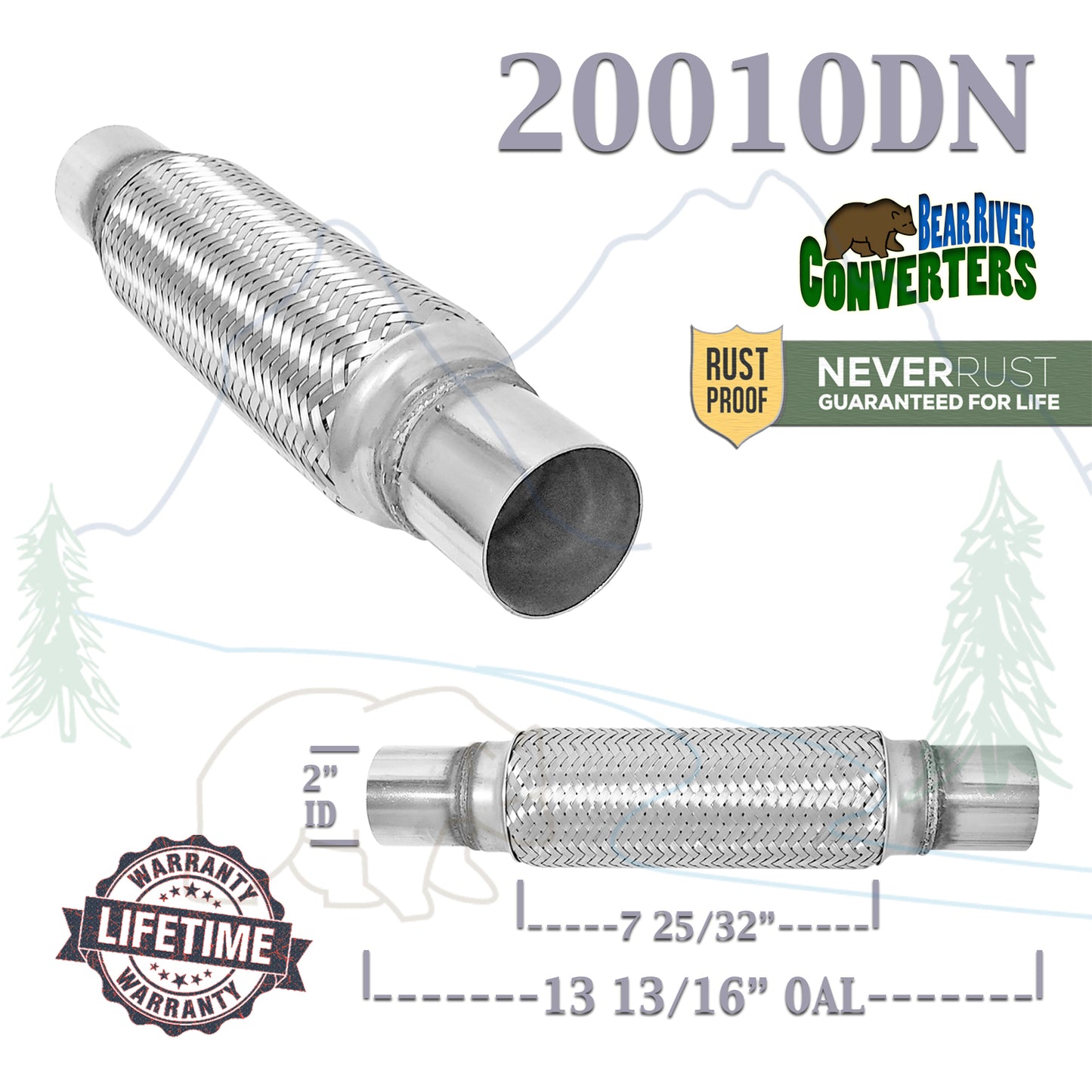1
/
of
3
Bear River Converters
2" x 10" x 14" Flex Pipe Exhaust Coupling Quality Stainless Heavy Duty w/ Ends
2" x 10" x 14" Flex Pipe Exhaust Coupling Quality Stainless Heavy Duty w/ Ends
Regular price
$23.96 USD
Regular price
$25.70 USD
Sale price
$23.96 USD
Unit price
/
per
Couldn't load pickup availability

20010DN 2" x 10" Flex Pipe
Inlet/Outlet: 2" ID
Visible Braid Length: 7.78125" (7 25/32")
Overall Length: 13.8125" (13 13/16")
Braid Outside Diameter: 2.90625" (2 29/32")
Triple Ply, Double Braid w/ Ends
Material: 304 Stainless Steel
Limited Lifetime Warranty*
What is a Flex Pipe?
A flex pipe, also sometimes known as a flex coupling, is a section of bellowed steel that is designed to absorb vibrations from the engine and from the motion of the vehicle, which prevents other components from being broken or cracked. Some parts of the exhaust system such as exhaust manifolds, (which are often made of cast iron) are brittle and easily break. Flex pipes prevent these components from being exposed to excessive stress.
How to use this Flex Pipe:
Measure the outside diameter (OD) of your exhaust pipe where you will be installing the flex pipe. Then, measure the length of the flex pipe that you are replacing (do not only measure the visible flex portion, flex pipes are always measured from weld to weld). Once you have these dimensions, use the chart above to determine the proper part # to purchase. Some flex pipes come with the option of pipe extensions already welded on to the flex. Extensions give you the option to expand the pipe size, if needed, for those odd-ball sized exhaust systems. Extensions allow for easier installation in some situations, and also allow for clamping. However, we always recommend welding to ensure a proper seal. Please note: flex pipes without extensions CANNOT be clamped, and must be welded. If your application requires a flex pipe next to an exhaust flange, DO NOT weld the flex pipe directly to the flange. Instead, weld it to exhaust pipe and weld the pipe to the flange. Flex pipes are NOT intended to replace bends such as those found in tailpipes. Flex pipes are NOT intended to be installed near the engine as it will cause it to overheat. Such use is likely to damage the flex and is NOT covered by warranty.
Bear River Flex Pipes:
Flex pipes can be made from a variety of different materials and can also differ in their construction techniques. Some companies use ordinary steel and/or may use aluminized steel (ordinary steel with an aluminum-based coating) which can rust and corrode. These materials typically do not last very long compared to stainless steel. Additionally, many competitors will crimp the fittings together, which allows water to become trapped in the crimped joint, encouraging corrosion. Some flex bellows are formed as a continuous helix, which can create exhaust turbulence and, in general, indicates that poor construction techniques are used. Competitors also have a loose braid pattern on the outer coverings (and inner coverings, if even present), which allows the flex to stretch too far, causing premature failure.
We do not compromise on our flex pipes! Not only are they lined with stainless steel, corrugated flexible tubing, but also have inner and outer T304 stainless steel braiding for added protection against rust. The double braid pattern is tightly woven to make them extra strong and heavy duty, as we believe that you want the best product for your money and that is why we do not offer second rate products.
Warranty:
We are so confident in the quality of our flex pipes, that we offer a guarantee that our flex pipes will not fail due to corrosion, cracking, or splitting for the lifetime of the vehicle. This warranty does not cover damage that may be the result of improper use, including, but not limited to: using the flex pipe to replace a bend, road damage, overheating, missing hangers, broken motor mounts, etc. If for any reason our flex joint fails under normal use, we will replace it free of charge. Your original invoice and picture of the failed flex while still installed will be required for warranty. Our warranty does not cover shipping, labor costs or other installation costs. It also does not cover any incidental or consequential damages.







